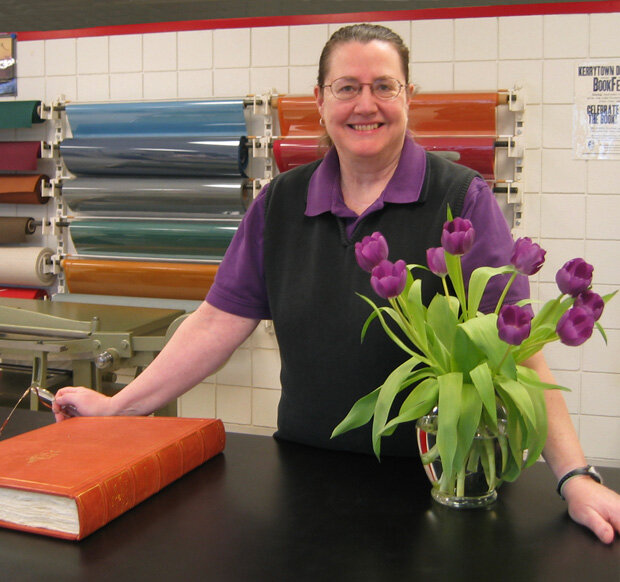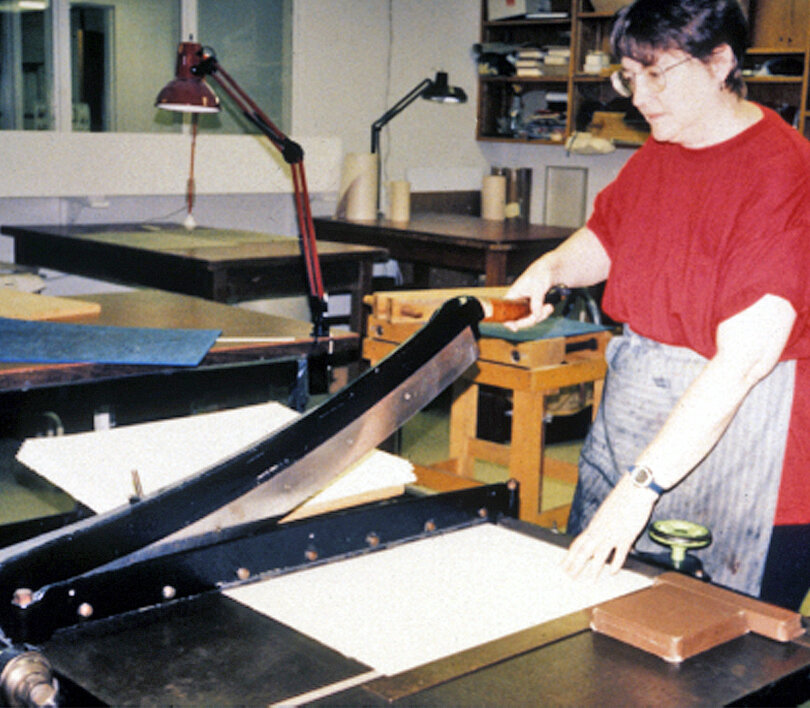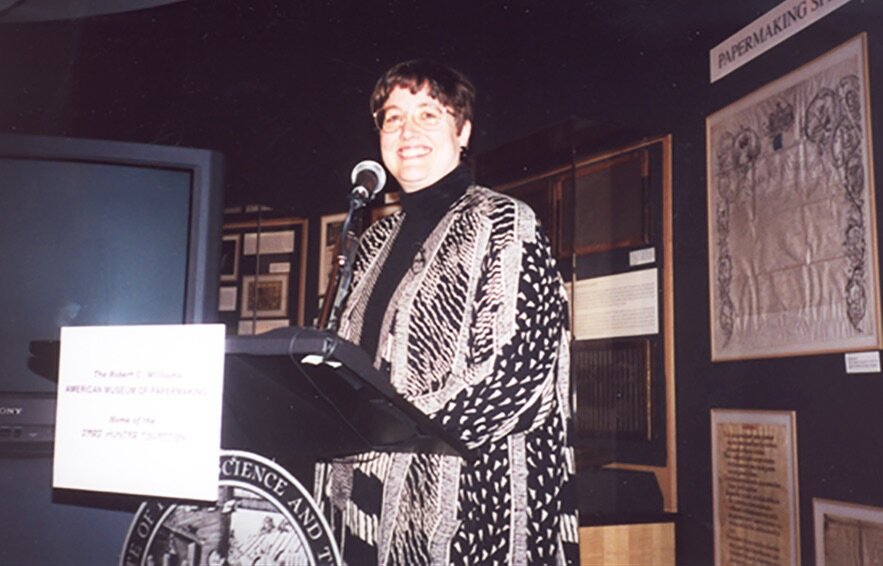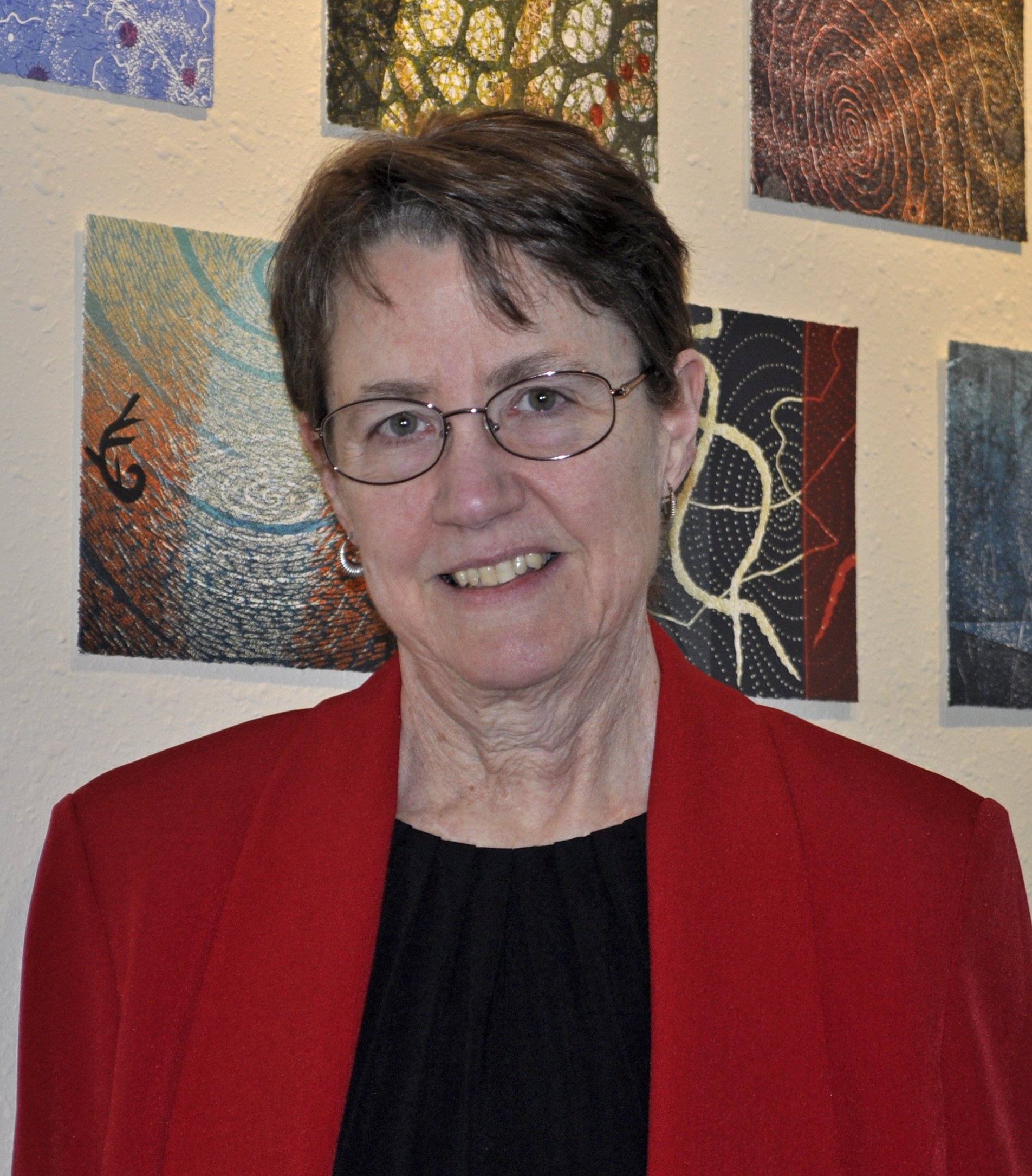
Cathleen A. Baker
PAPERMAKING CHAMPION
Cathy is a person who was passionate about what Dard Hunter added to the world. And in the making of BY HIS OWN LABOR: THE BIOGRAPHY OF DARD HUNTER discovered in herself the person who has added so much to the world of hand papermaking and the book in general.
Cathleen A. Baker
Papermaking Champion
It was 1993 when I was teaching at Ghost Ranch for Paper & Book Intensive that I met one of the other instructors, Cathy Baker. She told me she was working on the writing of a biography of the great handmade paper historian, paper maker and printer Dard Hunter. I knew and taught from his Bible on papermaking, PAPERMAKING: THE HISTORY AND TECHNIQUE OF AN ANCIENT CRAFT, and I understood immediately that this book, with Cathy's access to Dard Hunter III and Hunter's Mountain House in Chillicothe, Ohio, would be a true biography. Dard had written his own life story from his own perspective, but this book would be an objective story of his extraordinary experiences in world of hand papermaking. Before the PBI was finished I told Cathy I needed to be the book's publisher. It just felt right. And she agreed. That began nine years of her writing and me encouraging, not that she needed it; of our meetings around the country for the latest book update. Cathy ended up living at Mountain House and working with new materials from the safe in the basement.
Cathy decided that she needed to understand how to letterpress print and make paper, and she decided, to my surprise, to enroll in our MFA in Book Arts degree at The University of Alabama, where I taught both. She became a true partner in the making of BY HIS OWN LABOR: THE BIOGRAPHY OF DARD HUNTER. We took on the year-long challenge of letterpress printing all 368 pages of the book, two pages at a time, from metal type on dampened Twinrocker handmade paper made specifically for the book. One of us would read the manuscript text aloud while the other compared it to the type proofs, and we marched along printing from the first to the very last text page. We were reading and checking the text for typos on the day in the book that Dard died, and we had to stop for the day. We were filled with emotion. It was an arduous and very physical task to make this book. We both learned a lot. I believe it set the high standard for Cathy's own very successful Legacy Press.
Cathy is a person who was passionate about what Dard Hunter added to the world. And in the making of BY HIS OWN LABOR: THE BIOGRAPHY OF DARD HUNTER discovered in herself the person who has added so much to the world of hand papermaking and the book in general.
Steve Miller
October 12, 2020
See Cathy’s résumé here.

In 1978, Cathy arrived in Cooperstown, N.Y. from the Courtauld Institute of Art, University of London to teach paper conservation at the art conservation program.

Cathy in the University of Michigan Library’s conservation lab; March 2009. She retired in 2016 as Conservation Librarian Emerita.

Cathy cutting Twinrocker handmade paper for printing the limited edition of By His Own Labor: The Biography of Dard Hunter (BHOL); summer 1999.

Laying out printed paper to dry in stages. In all, about 16,000 sheets were dampened, printed, and dried for the BHOL; summer 1999

Cathy and Steve Miller examining a sheet of the BHOL, “hot off the press”; summer 1999.

The limited edition of BHOL, published by Miller’s Red Hydra Press, appeared in January 2000. The wood engraving of Dard Hunter was cut by John DePol.

Cathy at the RCWMP in Atlanta giving a lecture at her book signing; March 2000

Oak Knoll’s trade edition

Cathy at her table at the FDH and APHA joint annual meeting in Iowa City October 2018. Her imprint, The Legacy Press, began in 1997 and featured books printed by hand. In 2010, The Legacy Press began publishing books about the printing, paper, and bookbinding arts.

Full sheet of the first wove paper made in the West that appeared in John Baskerville’s Virgil (1757)

One phase of Cathy’s successful experiment to replicate the technique that must have been used by James Whatman I to make this paper: by placing a piece of cloth over an antique- laid mould. University of Iowa Center for the Book, August 2017.

Cathleen Baker of the Legacy Press, here at a Friends of Dard Hunter conference.
Cathleen A. Baker
Cathleen A. Baker’s contributions to the intersecting fields of heritage conservation and the material history of paper and books reflect a lifetime of study, observation, engagement—and an openness to risk. Many, many of us have had the privilege of learning from her directly through her teaching, lectures, and workshops. Orders of magnitude more have the benefit of her writing and publishing.
Dr. Baker holds multiple degrees that trace her deepening interest in paper and books: AB (history of art, 1967) from the University of Michigan; MA (history of art, 1986) from Syracuse University; MFA (book arts, 2000) from the University of Alabama; and PhD (mass communication, 2004) from the University of Alabama. She trained in paper conservation while working at the Courtauld Institute of Art at the University of London in the 1970s. On returning to the United States she took a position teaching paper conservation in the Art Conservation Department of the State University of New York College at Oneonta, Cooperstown (1978-1983), and SUNY College at Buffalo (1983–1993). In 2005 she returned to the University of Michigan as conservation and exhibits librarian in the University Library, from which she retired in 2016.
A superb teacher and mentor, Dr. Baker has supervised numerous students and aspiring conservators at the Cooperstown/Buffalo program and in national and international workshops. She taught classes on the history and materiality of books and paper at the University of Alabama, the U-M School of Information, and the Wayne State University School of Library and Information Science, as well as for the International Center for Conservation in Rome (ICCROM) in both Rome and Vienna in the 1980s and 1990s. She was the Judith Praska Distinguished Visiting Professor in Conservation and Technical Studies at the Institute of Fine Arts, Conservation Center, New York University, in 2015. In 2012 she was honored with the American Institute for Conservation (AIC) Sheldon and Caroline Keck Award, which recognizes a sustained record of excellence in the education and training of conservation professionals.
Her commitment to the growth and development of conservators has continued with a major gift to the University of Michigan Library to establish the Cathleen A. Baker Fellowship in Conservation in 2011. Each year the fellowship provides financial support for graduate student or mid-career paper or book conservators to engage in a research or practical project in the U-M Library Conservation Lab. The fellowship fosters learning, discovery, and the exchange of knowledge among practitioners.
Dr. Baker was a founding member of three important organizations for the conservation of cultural heritage: the Institute for Paper Conservation (UK), AIC Book and Paper Group, and the Friends of the Dard Hunter Paper Museum. In recognition of her accomplishments she was elected fellow of AIC and fellow of the International Institute for Conservation of Historic and Artistic Works. Among her many engagements in the history of the book community she has been an active member of the Friends of Dard Hunter (now North American Hand Papermakers), and is a member of the Grolier Club in New York City. She received a lifetime achievement award from the Guild of Book Workers in 2018.
Herself a researcher of great curiosity and dogged persistence, Dr. Baker has investigated a wide range of subjects pertaining to the history, technology, and applied sciences of paper, book production, and conservation. As an instructor and practitioner of paper conservation she has researched, written, and presented on technical topics of interest to her students and colleagues, such as papermaking, sizing agents, adhesives, and pH in paper. Her work is notable for its thoroughness, its clarity, and its strong practical applicability. Her definitive work on cellulose ethers continues to provide enlightenment where confusion of terms has often lead to misuses of the materials. Her 2005 short article (written with Randy Silverman) in International Preservation News single-handedly sparked international debate and reversed decades of insistence on cotton gloves in special collections: it has paved the way for new generations of scholars to experience and appreciate first-hand (literally!) the materiality of books and paper documents.
Dr. Baker’s growing interest in historical topics was sparked by her research into Audubon’s The Birds of America, conducted for her MA thesis. She took a hiatus from classroom teaching to pursue research full-time on the life and work of the seminal American paper historian Dard Hunter. Her investigations took her into previously unexplored archives at his former home in Chillicothe, Ohio, and resulted in her definitive biography: By His Own Labor: The Biography of Dard Hunter (2000). With Steve Miller of the Red Hydra press, she set type and printed a limited edition of the entire book by hand; a trade edition of the book was later produced by Oak Knoll Press. Her doctoral dissertation, “The Press that Cotton Built: Printing in Mobile, Alabama, 1850-1865,” investigated the early years of printing in the American South.
Her historical, technical, and pedagogical interests all came together in her 2010 book From the Hand to the Machine. Nineteenth-Century American Paper and Mediums: Technologies, Materials, and Conservation. From the Hand to the Machine is a textbook for conservation students, a reference for practitioners, and a manual for historians. She assembled the information about the technologies of papermaking, printing, drawing, and book illustration that she herself wanted to know when a novice conservator. The topic is nineteenth-century American paper and book-making technology, but in fact the text ranges widely in its insights. And while the book describes conservation treatments, it is not a how-to manual. Rather it is a why-do manual: the focus is on examination and decision-making for conservation and how an understanding of technological history feeds into those decisions. From the Hand to the Machine received the inaugural AIC Publication Award in 2012.
Over the past decade many themes of Dr. Baker’s career have coalesced into her micro-publishing house, The Legacy Press (thelegacypress.com). The Legacy Press is a one-person show: Dr. Baker personally solicits texts, edits and designs the books, contracts for printing and binding, and manages publicity and sales. Her years of close observation of the history and practice of printing and book design informs every smallest decision in the production of The Legacy Press books: she knows what a book can and should deliver in balancing form and content and she knows her reading audience. Her growing list of over twenty titles have made a significant impact on the published record of the history, technology, and practice of papermaking, bookbinding, printing, and conservation. She has provided a publishing venue where new writers in the field can feel comfortable giving it a try and experienced writers find support for esoteric (at least to mainstream publishers) subjects.
Most recently Dr. Baker has been pursuing research on John Baskerville’s 1757 Virgil—the book that paper historians cite as the first instance of the use of Western wove paper for book printing. She has now personally inspected nearly two hundred copies in collections across the United States and Europe. With her characteristic thoroughness she has not only examined the paper, but conducted experiments attempting to reproduce it. This research has revealed radically new insights into how wove paper was made and developed. She will have much to share in her upcoming book on the topic.
The persistent theme throughout Dr. Baker’s remarkable career has been the discovery and sharing of knowledge about paper and books. She has been unusual in finding so many different ways to do so—through teaching and mentoring, research and writing, and publishing—and in the wide group of people whose careers and understanding her work has influenced.
Shannon Zachary
January 12, 2021
Cathleen A. Baker recommended reading
“The Wove Paper in John Baskerville’s Virgil (1757): Made on a Cloth-Covered Laid Mould,” Papermaker’s Tears: Essays on the Art and Craft of Paper, vol. 1, ed. Tatiana Ginsberg. Ann Arbor, Mich.: The Legacy Press, 2019: 2–44.
“The Future of Library and Archives Conservation Education.” In Flood in Florence 1966: A Fifty-year Retrospective. Ed. Paul Conway and Martha O’Hara Conway. Ann Arbor: Maize Books: 2018: 190–196. http://quod.lib.umich.edu/m/maize/mpub9310956.
Audubon’s The Birds of America: A Technical Examination and Condition Survey of the Four Volume Folio Set Belonging to Syracuse University (includes information about the University of Michigan copy). Ann Arbor, Mich.: The Legacy Press, 2016. http://thelegacypress.com/miscellaneous.html.
“Nineteenth-Century Papers: Sizing Does Matter,” Hand Papermaking 30.2 (2015).
“Examination and Image-Capturing Techniques.” In Suave Mechanicals: Essays on the History of Bookbinding, vol. 2, ed. Julia Miller. Ann Arbor, Mich.: The Legacy Press, 2015: 2–18.
With Evyn Kropf. “A Conservative Tradition? Arab Papers of the 12th–17th Centuries from the Islamic Manuscripts Collection at the University of Michigan,” Journal of Islamic Manuscripts 4.1 (2013): 1–48. http://booksandjournals.brillonline.com/content/journals/10.1163/1878464-13040101.
From the Hand to the Machine. Nineteenth-Century American Paper and Mediums: Technologies, Materials, and Conservation. Ann Arbor, Mich.: The Legacy Press, 2010.
“Sodium Carboxymethylcellulose (SCMC) Re-evaluated for Paper, Book, Papyrus, and Parchment Conservation.” Book and Paper Group Annual 26 (2007): 177–185. http://cool.conservation-us.org/coolaic/sg/bpg/annual/
“Hand Papermaking in the Twentieth Century.” Journal Centennial Issue. New York: Guild of Book Workers, 2006. http://guildofbookworkers.org/content/journal-centennial-issue.
With Randy Silverman. “Misperceptions about White Gloves.” International Preservation News, 37 (December) 2005: 4–16. English and French, and translated into Japanese and Spanish. https://www.ifla.org/FR/publications/international-preservation-news.
With John DePol. Endgrain Designs & Repetitions: The Pattern Papers of John DePol. Tuscaloosa, Ala.: The Legacy Press, 2000 (limited edition letterpress); and Ann Arbor, Mich.: 2015 (trade edition).
By His Own Labor: The Biography of Dard Hunter. Limited edition letterpress: Tuscaloosa, Ala.: Red Hydra Press, 2000; and facsimile edition: New Castle, Del.: Oak Knoll Press, 2000.

Become an NAHP Member
Join our vibrant hand papermaking community and access your membership benefits.





